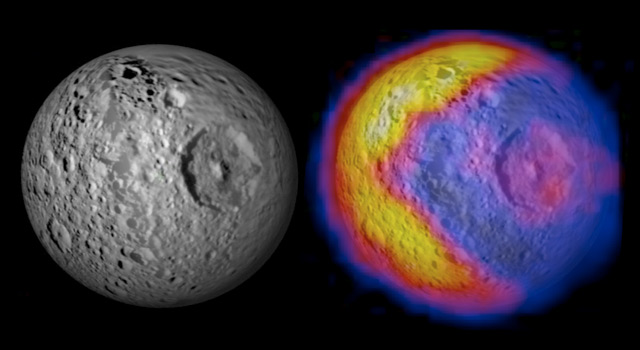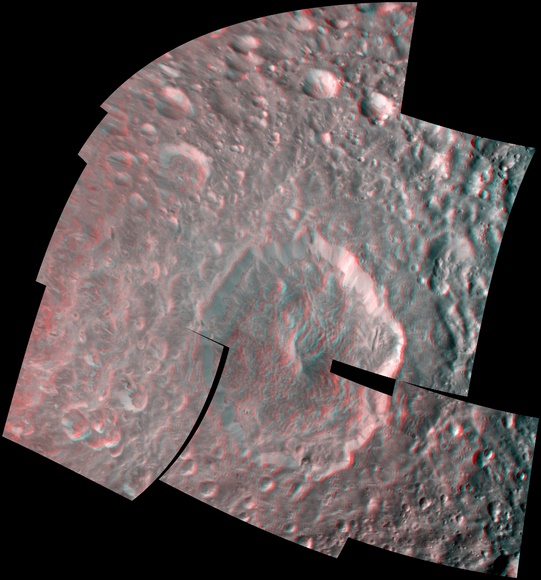The temperature map of the surface of the Saturnian moon Mimas is reminiscent of Pacman. The figure Pacman eats is Herschel's Crater, a 3D image of which is attached to the article. Prepare the XNUMXD glasses

Mimas has gained attention for being somewhat similar to (and perhaps even inspired) the Death Star from George Lucas' Star Wars series, but the new image from the Cassini spacecraft shows Saturn's 396 km diameter inner moon is even more interesting.
This is a high-resolution temperature map of Mimas that reveals surprising patterns on the small moon, including unexpectedly hot areas that look like Pac-Man eating Death Star Crater (officially known as Herschel Crater in the case of Mimas), as well as light and dark bands on the crater walls.
"Mimas is not a boring moon," said Caroline Porco, Cassini imaging team leader. She recommends wearing special XNUMXD glasses to view the giant Herschel Crater in XNUMXD (see photo below).
the spaceship

Cassini collected the data in transit near Mimas on February 13, and according to Porco, its team spent a lot of time improving the image. She said the details on the surface of the Saturnian moon reminded them of similar features on other Saturnian moons: Phoebe and Hyperion, although the thermal signature is strange and the crew has no explanation.
"Other moons have taken the spotlight, but Mimas turns out to be stranger than we thought," said Linda Spilker, JPL's Cassini project scientist. "He provides us with some new puzzles."
The scientists expected smooth changes in the temperature peaks in the early afternoon near the equator. Instead, these areas were actually warm in the morning along one of the edges of the lunar disc in a way reminiscent of Pacman's facial features. In the brightest areas, marked in yellow, the temperatures in the morning were around 92 degrees Kelvin (minus 181 Celsius). The rest of the moon was much colder - 77 degrees Kelvin (minus 196 degrees Celsius). One small hot spot (painted in red) - which looks like the spot in Pacman's mouth was in the Herschel Crater area - 84 degrees Kelvin (minus 189 Celsius).
The existence of a hot spot around Herschel makes sense because the computer walls, which are about 5 kilometers high, can trap heat inside the crater, but scientists still do not know what caused the sharp V-shaped shape at the edge of the visible region of the moon. "We suspect that the temperatures reveal differences in the surface composition," says John Spencer, who works on assembling images from the infrared spectrometer. "It's like the differences between old, compacted snow and fresh snowflakes."
Compacted snow quickly reflects sunlight from the surface and causes the area to remain cold during the day. Powdered snow is more insulating and it traps the sunlight hitting the ground, so the surface heats up.

2 תגובות
very weird..